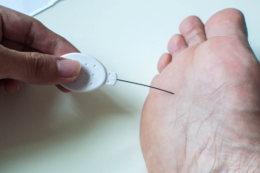Tagged with diabetic foot treatment …
How To Manage Blood Sugar for Healthy Feet
One common complication of having diabetes is foot problems. High glucose levels can cause nerve damage and poor blood circulation, which may lead to numbness, sores, and ulcers on the feet. If these conditions become severe, they can result in more serious issues, including foot deformities or amputations.
Hence, it’s crucial to manage your blood sugar. Aside from keeping your diabetes under control, doing so will also help prevent potential diabetic foot problems. Here’s what you should do:
Stay Active
Exercising on a regular basis is beneficial if you have diabetes as it makes your body more sensitive to insulin, lowering your blood sugar. It also helps reduce risks of cardiovascular diseases and reduce stress, which typically causes your glucose levels to spike up.
You don’t need an intense workout routine to stay active. Simply making a habit of walking at least 25-30 minutes a day is enough. You may also consider swimming or upper body workouts if you want to keep your heart rate up without putting too much strain on your feet.
Consume More Whole Foods
A healthy diet makes a huge difference if you want to manage your diabetes. Aside from limiting sugar and carb intake, adding fiber-rich and whole foods to your diet, like leafy greens, fruits, and whole grains, is best. Make sure to hydrate with water instead of choosing sodas or sugary drinks.
Stop Smoking
Apart from an increased risk for conditions like heart disease and stroke, using tobacco also affects how your body controls your blood sugar. Because of this, those who smoke are more likely to develop type 2 diabetes. If you need to quit, consider other nicotine replacements like patches, or talk to your doctor for the best action plan.
Ensure Routine Checkups
In addition to making a few lifestyle changes to control your glucose levels, it’s essential to visit your doctor regularly. A routine checkup allows you to keep track of your diabetes and medication and get professional advice on your diet and exercise.
It’s best to visit your foot doctor at least once a year. They can check for signs of potential foot problems through various tests and assessments and perform the necessary treatments. Your podiatrist may also provide more information on managing diabetic foot symptoms and proper foot care.
Consult a Diabetic Foot Specialist
Learning how to manage your blood sugar is one way you can prevent diabetic feet. Doing so also helps alleviate pain and other symptoms if you already have foot problems caused by diabetes. For a routine checkup or a diabetic foot treatment, reach out to Thomas Podiatry & Associates in Salisbury, MD today.






